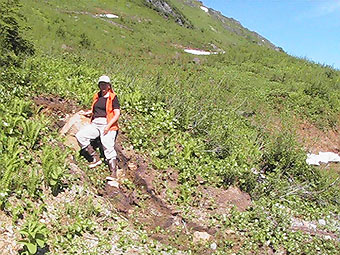

 | |||||||||
|
|
Journals 2007/2008Louise McMinn
July 16, 2007 Terry, Ron, George, Mike and I flew to Ragged Mountain today. We reviewed an area where they dug a trench last year. There is a distinct fault line along the Ragged Mountains, which we were able to clearly see from our second destination. This fault line indicated where the North American and the Yakutat terrane meet. We flew to a ridge opposite the Ragged Mountains, and examined a second trench. A few samples for carbon dating were taken at this site.
Next we flew down to the Katella River. We walked along the banks to observe a river cut. Years ago, a train track was built for mining that was done in the area. Distinct rock, silt, and peat layers could be seen in the cut away area. A bald eagle flew overhead, then sat in a tree watching us. As we were examining the river cut, the tide was rising. We made it back to the small beach, wading across a higher river, to wait for the helicopter. With so many people flying in different directions, it was hard to schedule. After a long day, we all arrived back at camp. Discussions continued throughout dinner, reviewing findings from the day and discussing past results. Each of the geologists has their own specialty areas, and they would compare their ideas about had happened. Geology is largely a study of how the Earth formed, and the many events that occurred to make our land like it is today. It requires a lot of teamwork to produce valid results. |
||||||||
